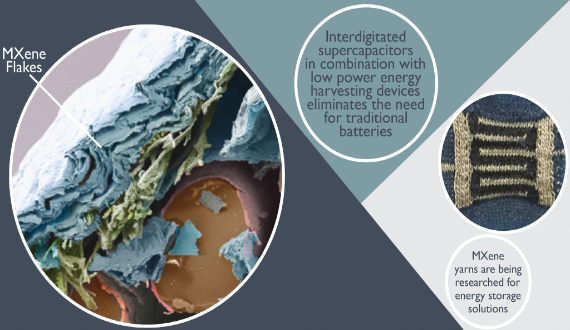
Covid-19 Response: MAKE MASKS @ Drexel
Facing an unprecedented demand for Personal Protective Equipment (PPE) at the height of the pandemic, the Pennsylvania Fabric Discovery Center (PA FDC) collaborated on a COVID-19 emergency response to produce new types of masks and respirators. Our network across Pennsylvania and the nation rapidly prototyped, ideated, tested and validated to swiftly respond to critical needs during the pandemic.
Learn More

Capacitive Touch Sensors
The Capacitive Touch Sensor (CTS) is a gesture sensitive functional textile touchpad interface for physical devices. The CTS is produced as a single piece of fabric requiring only two electrodes to connect it to a microcontroller. The CTS offers a solution for a flexible touch interface with consistent location detection, responsiveness, comfort and unobtrusiveness.
Learn More

Mxene Yarn
MXenes are a new family of two-dimensional (2D) transition metal carbides, carbonitrides and nitrides that were discovered and developed by Professors Michael Baroum and Yury Gogtsi in Drexel University’s Department of Materials Science and Engineering.
Learn More

Textile Energy Storage
Textile energy storage focuses on the need for safe and robust electrical energy storage solutions for textiles and wearable electronics, This project focuses on supercapcitors combine with low power energy harvesting devices, eliminating the need for bulky, traditional batteries.
Learn More

Smart Fabric Bellyband
A seamlessly knit bellyband that can monitor both maternity uterine activity and infant respiration to monitor and assess fetal and infant well-being. This project leverages conductive yarns, knitting technology, reconfigurable antennas and the use of a passive radio frequency identification (RFID) tags. The bellyband is a wireless, battery-less device that reduces bulk, improves comfort and enables greater mobility in pregnant women.
Learn More

Smart Fabric Sensors and Actuators
This project seeks to integrate smart fabric sensors and actuators into comfortable garment devices providing unobtrusive prevention options for deep venous thrombosis (DVT) that are not currently possible, particularly in high-risk patients. Whereas the majority of electronic textiles in existence today make use of circuits adhesively integrated onto a host garment, knitting technology at Drexel University enables the realization of garments that have knit sensors and actuators seamlessly integrated within them.
Learn More

Self-Folding in Weft Knit Textiles
The fundamental research aims to understand and control the self-folding behavior of weft knit textiles to harness this inherent property of the knot structure for development of novel engineered textiles
Learn More

Computational Modeling of Knitted Textile Architectures
Research developing robust data-driven simulation tools to study mechanical/multi-physics behavior of smart textiles using integrated computational materials engineering (ICME) strategy linking multiscale mechanical testing, numerical simulation, computational mechanics and manufacturing.
Learn More

Touch Sensitive for Hubo
Addresses the need for improvements to brittle composite enclosures and developed protective envelope prototypes for humanoid robots. A padded, flexible outerwear to mitigate fall and collision damage, and high tensile strength yarn used in production to provide abrasion resistance and additional protection.
Learn More

Exo-skin Soft Haptic Exoskeletal Interface
The Exo-Skin device is a knitted tendon actuated exoskeleton capable of delivering force and textural feedback to individual fingertip with applications for military use in for strength augmentation, the medical field for rehabilitation and commercially for gaming and haptic human computer interaction.
Learn More

Wi-Fi Power Harvesting
The merging of two projects has resulted in the concept of harvesting power to charge a supercapacitor. The Haute Tech Lab in collaboration is developing a proof of concept for textile energy storage and harvesting. Antennas are tuned to harvest or scavenge energy at 2.4 GHz from the Wi-Fi frequency band.
Learn More